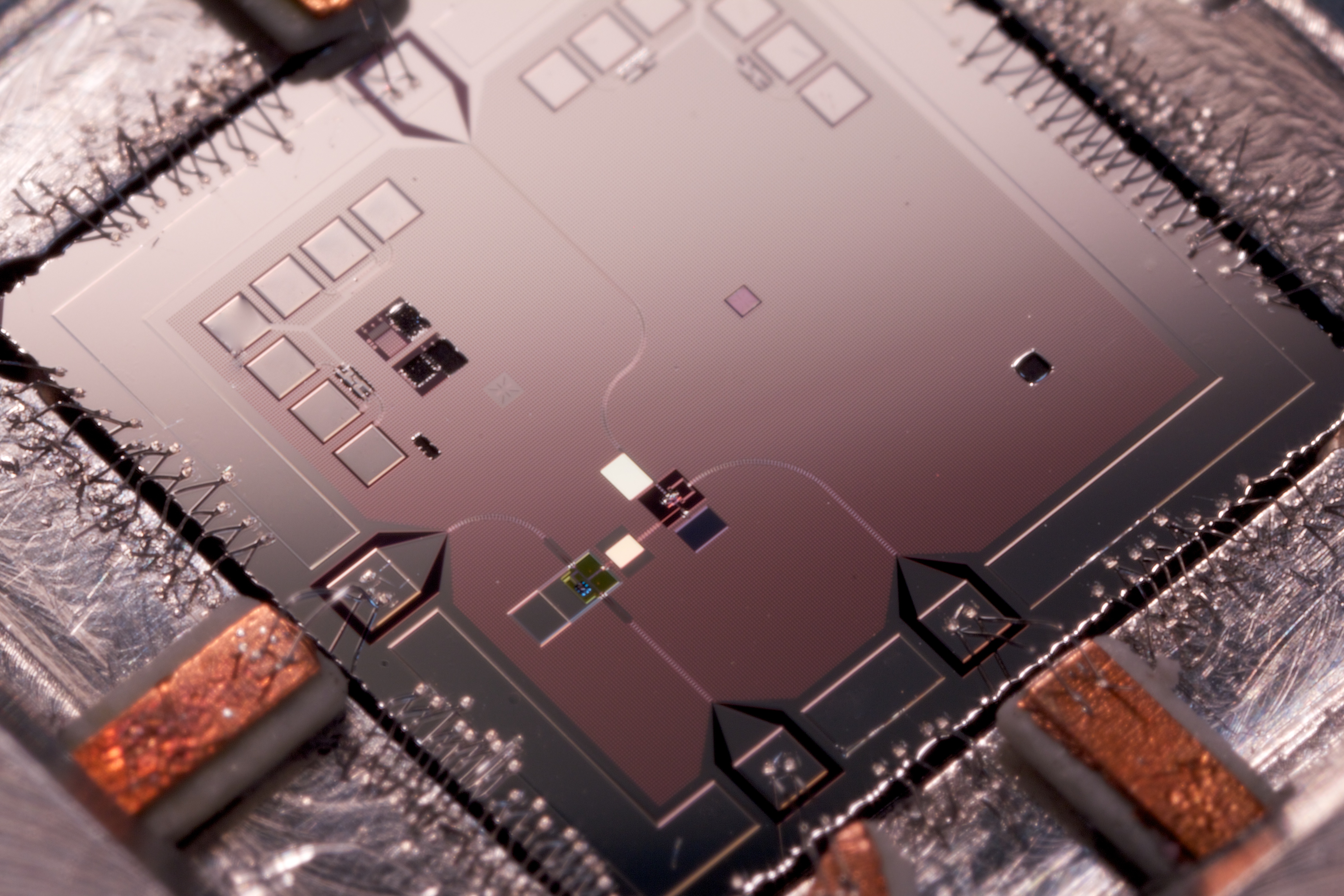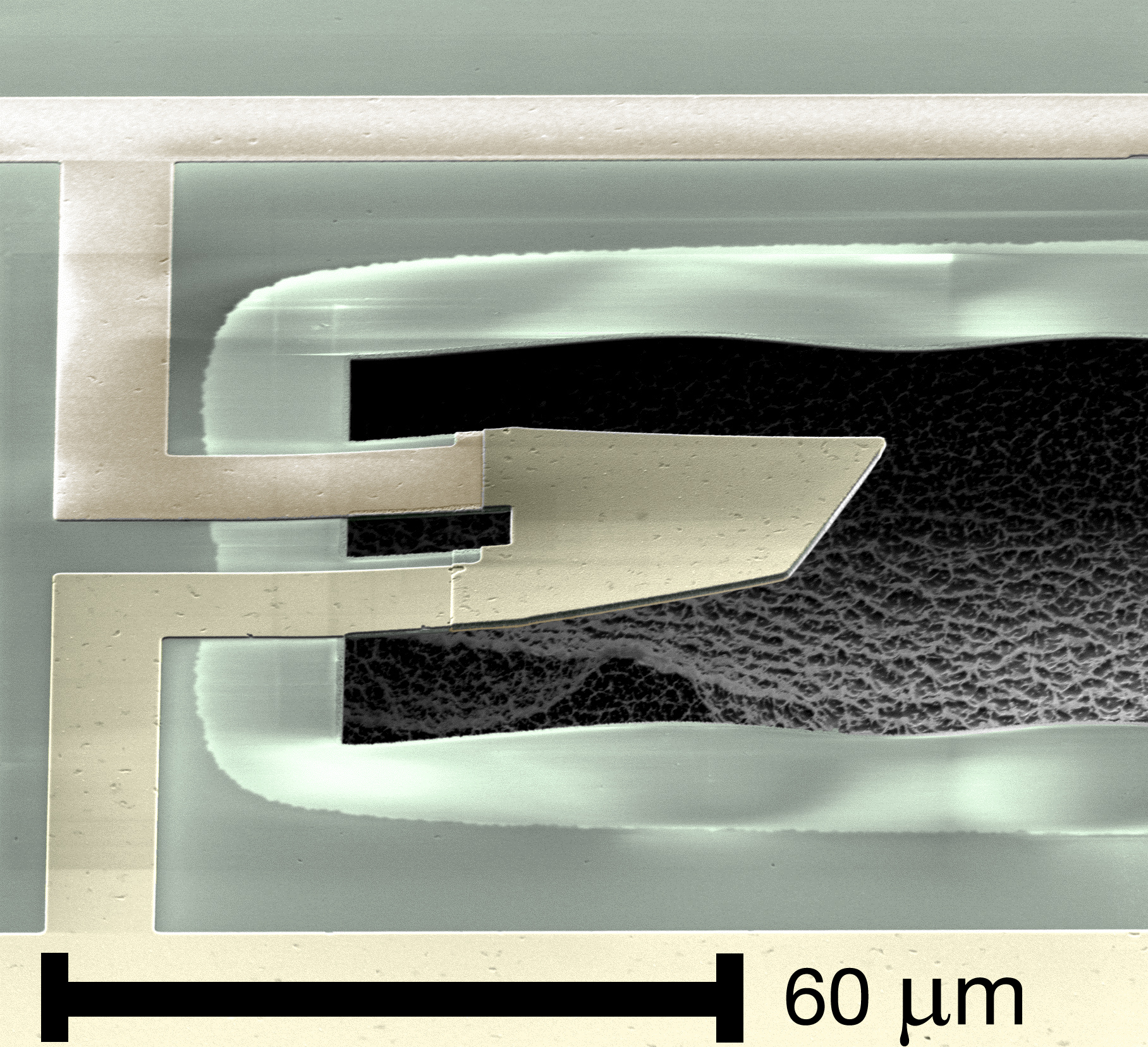Quantum machine on:
[Wikipedia]
[Google]
[Amazon]
 A quantum machine is a human-made device whose collective motion follows the laws of
A quantum machine is a human-made device whose collective motion follows the laws of
 The first quantum machine was created on August 4, 2009 by Aaron D. O'Connell while pursuing his Ph.D. under the direction of Andrew N. Cleland and John M. Martinis at the
The first quantum machine was created on August 4, 2009 by Aaron D. O'Connell while pursuing his Ph.D. under the direction of Andrew N. Cleland and John M. Martinis at the
"First quantum effects seen in visible object"
New Scientist, March 17, 2010 In the ''Nature'' paper, the team concluded "This demonstration provides strong evidence that quantum mechanics applies to a mechanical object large enough to be seen with the naked eye."
"A Macroscopic Mechanical Resonator Operated in the Quantum Limit"
(Ph.D. thesis) {{emerging technologies, quantum=yes, other=yes Quantum mechanics 2009 introductions Resonators
 A quantum machine is a human-made device whose collective motion follows the laws of
A quantum machine is a human-made device whose collective motion follows the laws of quantum mechanics
Quantum mechanics is a fundamental theory in physics that provides a description of the physical properties of nature at the scale of atoms and subatomic particles. It is the foundation of all quantum physics including quantum chemistry, q ...
. The idea that macroscopic objects may follow the laws of quantum mechanics dates back to the advent of quantum mechanics in the early 20th century. However, as highlighted by the Schrödinger's cat thought experiment
A thought experiment is a hypothetical situation in which a hypothesis, theory, or principle is laid out for the purpose of thinking through its consequences.
History
The ancient Greek ''deiknymi'' (), or thought experiment, "was the most anci ...
, quantum effects are not readily observable in large-scale objects. Consequently, quantum states of motion have only been observed in special circumstances at extremely low temperatures. The fragility of quantum effects in macroscopic objects may arise from rapid quantum decoherence. Researchers created the first quantum machine in 2009, and the achievement was named the "Breakthrough of the Year" by ''Science
Science is a systematic endeavor that Scientific method, builds and organizes knowledge in the form of Testability, testable explanations and predictions about the universe.
Science may be as old as the human species, and some of the earli ...
'' in 2010.
History
 The first quantum machine was created on August 4, 2009 by Aaron D. O'Connell while pursuing his Ph.D. under the direction of Andrew N. Cleland and John M. Martinis at the
The first quantum machine was created on August 4, 2009 by Aaron D. O'Connell while pursuing his Ph.D. under the direction of Andrew N. Cleland and John M. Martinis at the University of California, Santa Barbara
The University of California, Santa Barbara (UC Santa Barbara or UCSB) is a public land-grant research university in Santa Barbara, California with 23,196 undergraduates and 2,983 graduate students enrolled in 2021–2022. It is part of the ...
. O'Connell and his colleagues coupled together a mechanical resonator
A resonator is a device or system that exhibits resonance or resonant behavior. That is, it naturally oscillates with greater amplitude at some frequencies, called resonant frequencies, than at other frequencies. The oscillations in a reson ...
, similar to a tiny springboard, and a qubit, a device that can be in a superposition of two quantum states at the same time. They were able to make the resonator vibrate a small amount and a large amount simultaneously—an effect which would be impossible in classical physics. The mechanical resonator was just large enough to see with the naked eye—about as long as the width of a human hair.
The groundbreaking work was subsequently published in the journal ''Nature
Nature, in the broadest sense, is the physical world or universe. "Nature" can refer to the phenomena of the physical world, and also to life in general. The study of nature is a large, if not the only, part of science. Although humans ar ...
'' in March 2010. The journal ''Science
Science is a systematic endeavor that Scientific method, builds and organizes knowledge in the form of Testability, testable explanations and predictions about the universe.
Science may be as old as the human species, and some of the earli ...
'' declared the creation of the first quantum machine to be the " Breakthrough of the Year" of 2010.
Cooling to the ground state
In order to demonstrate the quantum mechanical behaviour, the team first needed to cool the mechanical resonator until it was in its quantum ground state (the state with the lowest possible energy). Specifically, a temperature was required, where is thePlanck Constant
The Planck constant, or Planck's constant, is a fundamental physical constant of foundational importance in quantum mechanics. The constant gives the relationship between the energy of a photon and its frequency, and by the mass-energy equivalen ...
, is the frequency
Frequency is the number of occurrences of a repeating event per unit of time. It is also occasionally referred to as ''temporal frequency'' for clarity, and is distinct from '' angular frequency''. Frequency is measured in hertz (Hz) which is ...
of the resonator and is the Boltzmann constant
The Boltzmann constant ( or ) is the proportionality factor that relates the average relative kinetic energy of particles in a gas with the thermodynamic temperature of the gas. It occurs in the definitions of the kelvin and the gas consta ...
. Previous teams of researchers had struggled with this stage, as a 1 MHz resonator, for example, would need to be cooled to the extremely low temperature of 50 μK. O'Connell's team constructed a different type of resonator, a film bulk acoustic resonator, with a much higher resonant frequency (6 GHz) which would hence reach its ground state at a (relatively) higher temperature (~0.1 K); this temperature could then be easily reached with a dilution refrigerator. In the experiment, the resonator was cooled to 25 mK.
Controlling the quantum state
The film bulk acoustic resonator was made of piezoelectric material, so that as it oscillated its changing shape created a changing electric signal, and conversely an electric signal could affect its oscillations. This property enabled the resonator to be coupled with a superconducting phase qubit, a device used inquantum computing
Quantum computing is a type of computation whose operations can harness the phenomena of quantum mechanics, such as superposition, interference, and entanglement. Devices that perform quantum computations are known as quantum computers. Thou ...
whose quantum state can be accurately controlled.
In quantum mechanics, vibrations are made up of elementary vibrations called phonons. Cooling the resonator to its ground state can be seen as equivalent to removing all of the phonons. The team was then able to transfer individual phonons from the qubit to the resonator. The team was also able to transfer a superposition state, where the qubit was in a superposition of two states at the same time, onto the mechanical resonator. This means the resonator "literally vibrated a little and a lot at the same time", according to the '' American Association for the Advancement of Science''. The vibrations lasted just a few nanoseconds before being broken down by disruptive outside influences.Richard Webb"First quantum effects seen in visible object"
New Scientist, March 17, 2010 In the ''Nature'' paper, the team concluded "This demonstration provides strong evidence that quantum mechanics applies to a mechanical object large enough to be seen with the naked eye."
Notes
References
External links
* * * Aaron D. O'Connell, December 2010"A Macroscopic Mechanical Resonator Operated in the Quantum Limit"
(Ph.D. thesis) {{emerging technologies, quantum=yes, other=yes Quantum mechanics 2009 introductions Resonators